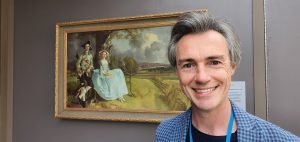Presenter, lecturer and guide Simon described h ow due to the growing interest in having national art collections (France opened the Louvre in 1789, the original Rijsmuseum was opened in 1798 and the Prado in 1819), Britain decided to open a “National Gallery” in the home of John Julius Angertein in London whose eclectic collection of 38 paintings was bought by the then government in the interest of starting a national collection and at the behest of Sir George Beaumont, whose “An Autumn Landscape” (1636) by Peter Paul Rubens had inspired John Constable to paint “The Haywain (1821). He bequeathed his own collection of 17 paintings to this new collection. This “National Gallery” opened on 10th May 1824. However the Pall Mall building was quickly deemed too small and a competition was launched to design a new purpose built building which was won by William Wilkins (1778-1839). This new Gallery in Trafalgar Square opened in 1838.
ow due to the growing interest in having national art collections (France opened the Louvre in 1789, the original Rijsmuseum was opened in 1798 and the Prado in 1819), Britain decided to open a “National Gallery” in the home of John Julius Angertein in London whose eclectic collection of 38 paintings was bought by the then government in the interest of starting a national collection and at the behest of Sir George Beaumont, whose “An Autumn Landscape” (1636) by Peter Paul Rubens had inspired John Constable to paint “The Haywain (1821). He bequeathed his own collection of 17 paintings to this new collection. This “National Gallery” opened on 10th May 1824. However the Pall Mall building was quickly deemed too small and a competition was launched to design a new purpose built building which was won by William Wilkins (1778-1839). This new Gallery in Trafalgar Square opened in 1838. 
William Turner died in 1851 leaving all his works to the National Gallery on condition that his “Dido building Carthage” be displayed next to Claude of Lorraine’s “Seaport with Embarcation of the Queen of Sheba” in perpetuity – which it is to this day.
In 1855 Sir Charles Eastlake (already President of the Royal Academy) became the first Director of the National Gallery and with an annual income of £10,000 from the government, lay the foundations of the art collection that we know today, travelling to Europe and buying many paintings from Italy, including “The Virgin and Child Enthroned” (1263/64) by Margarito d’Arezzo, and widening the scope of the collection. It was further enlarged by receiving some of Prince Albert’s paintings from Germany upon his death, and in 1877 Sir Robert Peel bequeathed all his Flemish paintings to the Gallery too. In 1889 Henry Tate offered his collection of Pre-Raphaelite and British paintings but it was turned down by the trustees due to lack of space. Hence the Tate Gallery was subsequently born – now Tate Britain.
Art students had always been encouraged to go to the Gallery and draw and copy the paintings and this became so popular that in 1899, the first hour of opening from 10-11am was reserved especially for students on Thursdays and Fridays. In 1903 an official budget for the National Art Collection was created. “The Art Fund” was promptly used to purchase “The Toilet of Venus”, also known as “The Rokeby Venus” which was subsequently attacked and slashed by Canadian suffragette Mary Richardson. More recently it was also attacked by the “Stop Oil” movement in 2023, but in each case it has survived and been restored.
During World War II, when Kenneth Clark was Director (1934-1945) most of the paintings were sent to the slate mines in Wales for safe keeping where a lot of work of cataloguing and conservation was done on them In the meantime Dame Myra Hess gave weekly piano concerts (1940-1946) in the Gallery to keep people’s spirits up. He
The only painting to ever be stolen from the Gallery was “Portrait of the Duke of Wellington” By Francisco Goya, which was taken by Kempton Bunton in 1961 as a protest against pensioners having to pay the TV Licence Fee. He kept it for 4 years above his fireplace but he was subsequently caught and sent to prison for four years.
Throughout the 20th and into the 21st Centuries, the Gallery has continued to expand and modernize. For this 200th Anniversary, 12 paintings will be exhibited across the country continuing its purpose which has always been to be a “means for public enjoyment”.
20th and into the 21st Centuries, the Gallery has continued to expand and modernize. For this 200th Anniversary, 12 paintings will be exhibited across the country continuing its purpose which has always been to be a “means for public enjoyment”.
A fascinating lecture, enthusiastically presented.
Liz Beecheno
